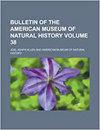Osteology of The Middle Eocene Ceratomorph Hyrachyus modestus (Mammalia, Perissodactyla)
IF 3.4
2区 环境科学与生态学
Q1 BIODIVERSITY CONSERVATION
Bulletin of the American Museum of Natural History
Pub Date : 2017-06-09
DOI:10.1206/0003-0090-413.1.1
引用次数: 13
Abstract
ABSTRACT The middle Eocene ceratomorph Hyrachyus has been considered a pivotal genus in ceratomorph evolution, either as a transitional form from tapiroids to rhinocerotoids, giving rise to all later rhinocerotoids, or else as the sister taxon to other rhinocerotoids. Thus, Hyrachyus has been commonly chosen as an outgroup in phylogenetic analyses of rhinocerotoids. However, little has been published on the osteology of Hyrachyus, even though well-preserved craniodental and postcranial specimens of this taxon have been in collections for decades. Here, we describe and illustrate the cranial and postcranial osteology of Hyrachyus modestus, based mainly on the exceptionally preserved specimens housed at the American Museum of Natural History, specifically AMNH FM 12664. Our bone-by-bone description provides detailed information on the osteological morphology of Hyrachyus, which should be useful for phylogenetic analyses of both rhinocerotoids and perissodactyls in general, because it provides one of the more complete and best-preserved examples of the skeleton of an earlier Eocene perissodactyl. The cranial morphology of Hyrachyus modestus shows a shallow narial notch, a lacrimal contacting the nasal, and a sphenorbital fissure closely situated to the anterior opening of the alisphenoid canal. In the basicranial region, there is a mastoid exposure of the petrosal between the occipital and the squamosal, and the posttympanic process and paracondylar process are partly fused. The postcranial morphology of Hyrachyus modestus includes the following features: The cervical region of the vertebral column is relatively short compared to the rest of the vertebral column. The lumbar vertebrae have concave-convex embracing prezygapophyses and postzygapophyses. The scapula has a distinct acromion process. The humerus has a greater tubercle that does not elevate above the head, and the deltoid tuberosity and deltopectoral crest are weak. The scaphoid and lunar facets of the radius are confluent. The olecranon of the ulna extends posteroproximally. The manus is functionally tetradactyl, with a complete fifth manual digit. The innominate bone has a long, narrow coxal tuberosity. The greater trochanter of the femur is elevated proximally above the head. The femur has a long, narrow, and symmetric trochlea. The patella has a moderately anteroposteriorly deep base. The intercondyloid eminences of the tibia are equal in height, and the extensor sulcus of the tibia is relatively deep. The fibula has a relatively slender shaft with expanded ends. The pes has three functional digits. The calcaneus does not contact the navicular, nor does the Mt III contact the cuboid. Comparisons between the skeleton of Hyrachyus modestus and those of the early tapiroid Heptodon, the hyracodontid Triplopus, the paraceratheriid Juxia, and the rhinocerotid Uintaceras were also investigated. These results indicate that Hyrachyus probably did not derive from Heptodon, but from a more basal group of ceratomorphs. Furthermore, distinct differences between the skeletons of Hyrachyus and Triplopus (the earliest representative of Hyracodontidae) suggest that hyracodontids were not descended from Hyrachyus. However, Hyrachyus-like ancestors probably gave rise to other non-hyracodontid rhinocerotoids. Like that of other Eocene perissodactyls, the postcranial morphology of Hyrachyus modestus exhibits adaptations that suggest that cursorial locomotion was already present early in perissodactyl evolution.中始新世角化兽(哺乳目,准足趾目)的骨学
中始新世角鼻虫Hyrachyus被认为是角鼻虫进化过程中的一个关键属,它是角鼻虫从类貘到类鼻虫的过渡形式,产生了所有后来的类鼻虫,或者是其他类鼻虫的姐妹分类群。因此,在类犀牛的系统发育分析中,水螅类通常被选为外群。然而,尽管保存完好的颅齿和颅后标本已经被收集了几十年,但关于水龙的骨学研究却很少发表。在这里,我们主要基于美国自然历史博物馆保存的特殊标本,特别是AMNH FM 12664,描述和说明了水龙的颅骨和颅后骨学。我们对每块骨头的描述提供了水龙骨形态的详细信息,这对于类鼻兽和一般的异趾龙的系统发育分析都是有用的,因为它提供了始新世早期异趾龙骨骼的一个更完整和保存最好的例子。小圆鼻蛇的颅骨形态为浅鼻切迹,泪道与鼻腔相连,蝶眶裂紧靠翼蝶骨管的前开口。在颅底区,枕骨和鳞骨之间的岩骨有乳突暴露,鼓室后突和髁旁突部分融合。后颅形态包括以下特征:与脊柱的其余部分相比,脊柱的颈椎区域相对较短。腰椎呈凹凸状,包括肩关节前和肩关节后。肩胛骨有明显的肩峰突。肱骨有一个不高于头部的大结节,三角结节和三角胸峰较弱。桡骨的舟状面和月状面汇合。尺骨鹰嘴后近端延伸。手在功能上是四指形的,有完整的第五个手指。无名骨有一长而窄的尾结节。股骨大转子在头部上方近端升高。股骨有一个长、窄、对称的滑车。髌骨有一个中等正后方深的基底。胫骨髁间突高度相等,胫骨伸肌沟相对较深。腓骨有一个相对细长的轴,末端扩张。pes有三个功能性数字。跟骨不接触舟骨,第三股肌也不接触长方体。本文还比较了普通水龙与早期tapioid Heptodon、hyracodontid Triplopus、paraceroid Juxia和rhinocerotid untaceras的骨骼。这些结果表明Hyrachyus可能不是来自七齿兽,而是来自一个更基础的角兽类。此外,水龙与水龙科最早的代表——三足龙的骨骼差异表明,水龙不是水龙的后代。然而,类水螅类的祖先可能产生了其他非水螅类的类鼻。和其他始新世的异趾龙一样,普通蹄龙的后颅形态显示出适应性,这表明在异趾龙进化的早期就已经出现了移动运动。
本文章由计算机程序翻译,如有差异,请以英文原文为准。
求助全文
约1分钟内获得全文
求助全文
来源期刊
CiteScore
7.90
自引率
2.90%
发文量
4
审稿时长
>18 weeks
期刊介绍:
The Bulletin, published continuously since 1881, consists of longer monographic volumes in the field of natural sciences relating to zoology, paleontology, and geology. Current numbers are published at irregular intervals. The Bulletin was originally a place to publish short papers, while longer works appeared in the Memoirs. However, in the 1920s, the Memoirs ceased and the Bulletin series began publishing longer papers. A new series, the Novitates, published short papers describing new forms.

 求助内容:
求助内容: 应助结果提醒方式:
应助结果提醒方式:


